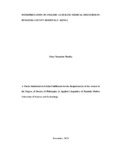| dc.description.abstract | In this age of massive travel and migration, many doctors find themselves attending to
patients with whom they do not share a common language. In such situations,
interpretation is employed to bridge the linguistic gap in this vital communication. This
study investigated the interpretation of English-Lubukusu medical discourse in a nonnative
doctor and a Bukusu patient consultation in Bungoma County Hospitals in
Kenya. The specific objectives of the study were to: establish the interpretability of
English medical terminologies into Lubukusu, identify the interpretation strategies
employed by interpreters in a non-native doctor-Bukusu patient consultation
discourse, identify constraints in the interpretation events and ascertain whether there
is loss or gain of meaning in English-Lubukusu medical interpretation. The analytical
research design was adopted in the study. The consultants for the study were selected
using purposive sampling technique that targeted two non-native doctors at the
Bungoma County Referral Hospital and two non - native doctors at each of the selected
five Sub-County hospitals in Bungoma County, their interpreters and twelve patients.
For purposes of ethical considerations and patients’ privacy, six nurses who are
proficient in Lubukusu working at the health facilities and had interpreted for nonnative
doctors in consultations with Bukusu patients acted as patients in this study,
referred to as Standardized Patients (SP). During data collection, some patients who
were interested in the research requested to partake in the research. They signed the
consent forms and were recorded in real consultations. Six SPs and six actual patients
were used in this study. Sytematic random sampling was used to select the linguistic
sample. Data was collected by use of questionnaires, audio-recording and observation.
The researcher audio recorded two consultation sessions for every doctor with one
patient or SP on different appointments and analyzed the data majorly by qualitative
methods with some instances of quantitative analysis. The Pragmatic Model of
Simultaneous Interpretation propounded by Setton (1999) guided the collection,
analysis and interpretation of data. The results of this study reveal that there are
English medical terms that have no equivalents in Lubukusu hence are noninterpretable.
Interpreters in medical consultations encounter constraints and employ
a number of strategies to overcome them. None of the interpreters involved in this
study had had any formal training in interpretation. Consequently, cases of meaning
loss were recorded whenever the interpreters failed to balance the use of strategies to
overcome the constraints. This study recorded the highest level of equivalence in
interpretation events by medical officers which gave rise to gain in meaning. It is
hoped that the results of the study will inform both the County government of
Bungoma and the government of Kenya on ways of ensuring the Kenyan citizens
benefit most from the presence of the doctors from other counties and countries in the
health facilities. The results of this study offer a variety of strategies that will maximize
the outcome of the communication between doctors and nurses who do not share a
language. The study recommends that the government trains and employs interpreters
in health facilities where non-native doctors are posted to bridge the communication
gap between the doctors and local patients who may not be proficient in English. | en_US |

